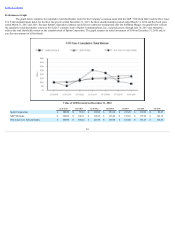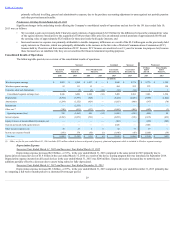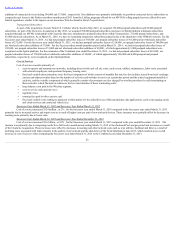Sprint - Nextel 2015 Annual Report Download - page 36
Download and view the complete annual report
Please find page 36 of the 2015 Sprint - Nextel annual report below. You can navigate through the pages in the report by either clicking on the pages listed below, or by using the keyword search tool below to find specific information within the annual report.
Table of Contents
Segment Earnings - Wireless
Wireless segment earnings are a function of wireless service revenue, the sale of wireless devices (handsets and tablets), broadband devices, connected
devices and accessories, leasing wireless devices, in addition to costs to acquire subscribers and network and interconnection costs to serve those subscribers, as
well as other Wireless segment operating expenses. The costs to acquire our subscribers include the cost at which we sell our devices as well as the marketing and
sales costs incurred to attract those subscribers. Network costs primarily represent switch and cell site costs, backhaul costs, and interconnection costs, which
generally consist of per-minute usage fees and roaming fees paid to other carriers. The remaining costs associated with operating the Wireless segment include the
costs to operate our customer care organization and administrative support. Wireless service revenue, costs to acquire subscribers, and variable network and
interconnection costs fluctuate with the changes in our subscriber base and their related usage, but some cost elements do not fluctuate in the short term with these
changes.
As shown by the table above under "Consolidated Results of Operations," Wireless segment earnings represented almost all of our total consolidated
segment earnings for the year ended March 31, 2016 . Within the Wireless segment, postpaid wireless services represent the most significant contributors to
earnings, and is driven by the number of postpaid subscribers to our services, as well as ARPU. The wireless industry is subject to competition to retain and acquire
subscribers of wireless services. Most markets in which we operate have high rates of penetration for wireless services.
Device Financing Programs
In September 2013, we introduced an installment billing program that allows subscribers to purchase a device by paying monthly installments generally
over 24 months. In September 2014, we introduced a leasing program, whereby qualified subscribers can lease a device for a contractual period of time.
Under the installment billing program, we recognize a majority of the revenue associated with future expected installment payments at the time of sale
of the device. As compared to our traditional subsidized programs, this results in better alignment of the equipment revenue with the cost of the device. The impact
to Wireless earnings from the sale of devices under our installment billing program is neutral except for the impact from the time value of money element related to
the imputed interest on the installment receivable.
Under the leasing program, qualified subscribers can lease a device for a contractual period of time. At the end of the lease term, the subscriber has the
option to turn in their device, continue leasing their device, or purchase the device. As of March 31, 2016 , substantially all of our device leases were classified as
operating leases. As a result, at lease inception, the devices are reclassified from inventory to property, plant and equipment when leased through Sprint's direct
channels. For leases in the indirect channel, we purchase the devices at lease inception from the dealer, which is then capitalized to property, plant and equipment.
While a majority of the revenue associated with installment sales is recognized at the time of sale along with the related cost of products, lease revenue is recorded
monthly over the term of the lease and the cost of the device is depreciated to its estimated residual value generally over the lease term. During the years ended
March 31, 2016 and 2015 , we leased devices through our Sprint direct channels totaling approximately $3.2 billion and $1.2 billion , respectively. These devices
were reclassified from inventory to property, plant and equipment and, as such, the cost of the device was not recorded as cost of products compared to when
purchased under the installment billing or traditional subsidized programs, which resulted in a significant positive impact to Wireless segment earnings.
Depreciation expense incurred on all leased devices for the years ended March 31, 2016 and 2015 was $1.8 billion and $206 million , respectively. If the mix of
leased devices continues to increase, we expect this positive impact on the financial results of Wireless segment earnings to continue and depreciation expense to
increase. However, this benefit to Wireless segment earnings will be partially offset by the Handset Sale-Leaseback Tranche 1 transaction that was consummated
in November 2015 where we sold and subsequently leased back certain devices leased to our customers (see HandsetSale-Leasebackin Liquidity and Capital
Resources for further details). As a result, our cost of the devices sold to Mobile Leasing Solutions, LLC (MLS) is no longer recorded as depreciation expense, but
rather recognized as rent expense within “Cost of products” during the leaseback periods.
Our device leasing and installment billing programs require a greater use of operating cash flows in the earlier part of the device contracts as our
subscribers will generally pay less upfront than traditional subsidized programs. The Accounts Receivable Facility and the Handset Sale-Leaseback transactions
(See AccountsReceivableFacilityand HandsetSale-Leasebackin Liquidity and Capital Resources for further details) were designed to mitigate the significant use
of cash from purchasing devices from original equipment manufacturers (OEMs) to fulfill our installment billing and leasing programs.
34
























